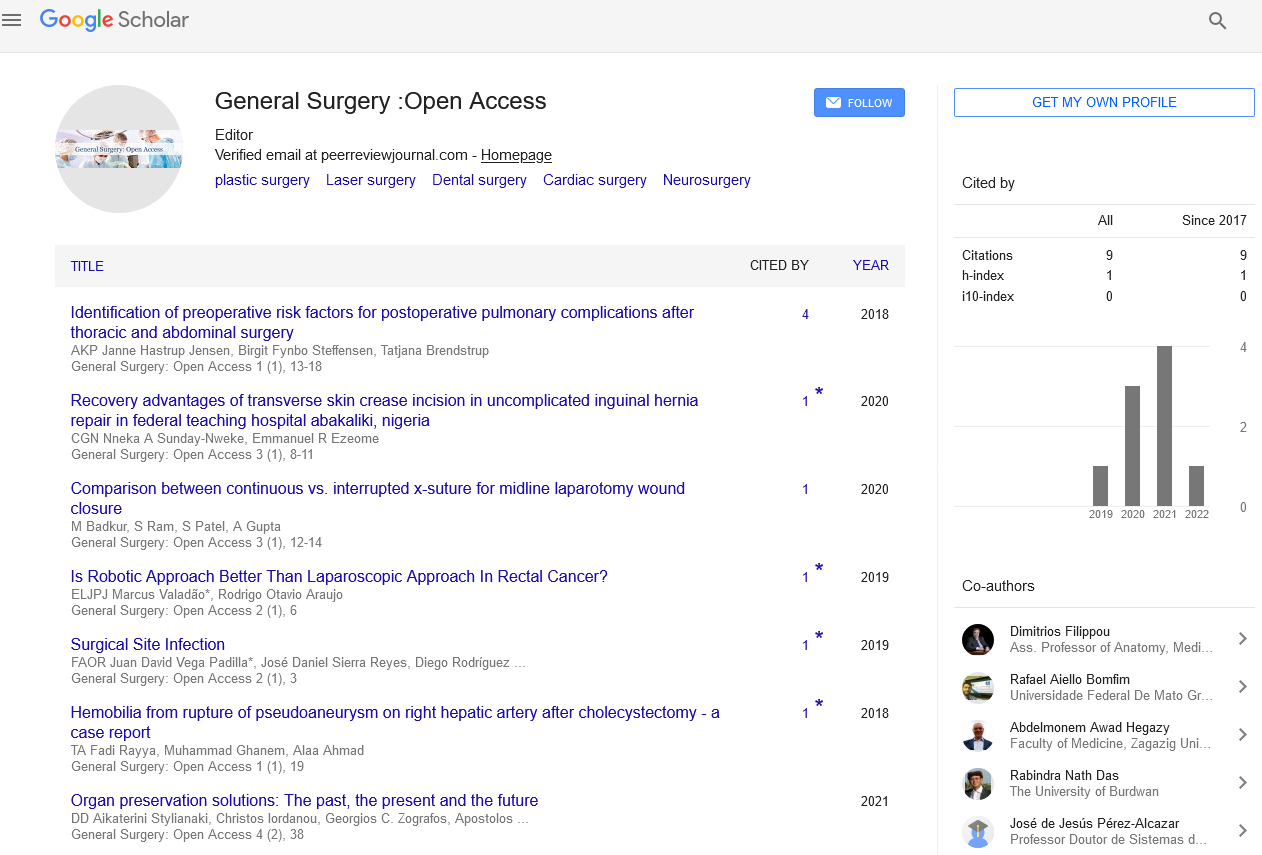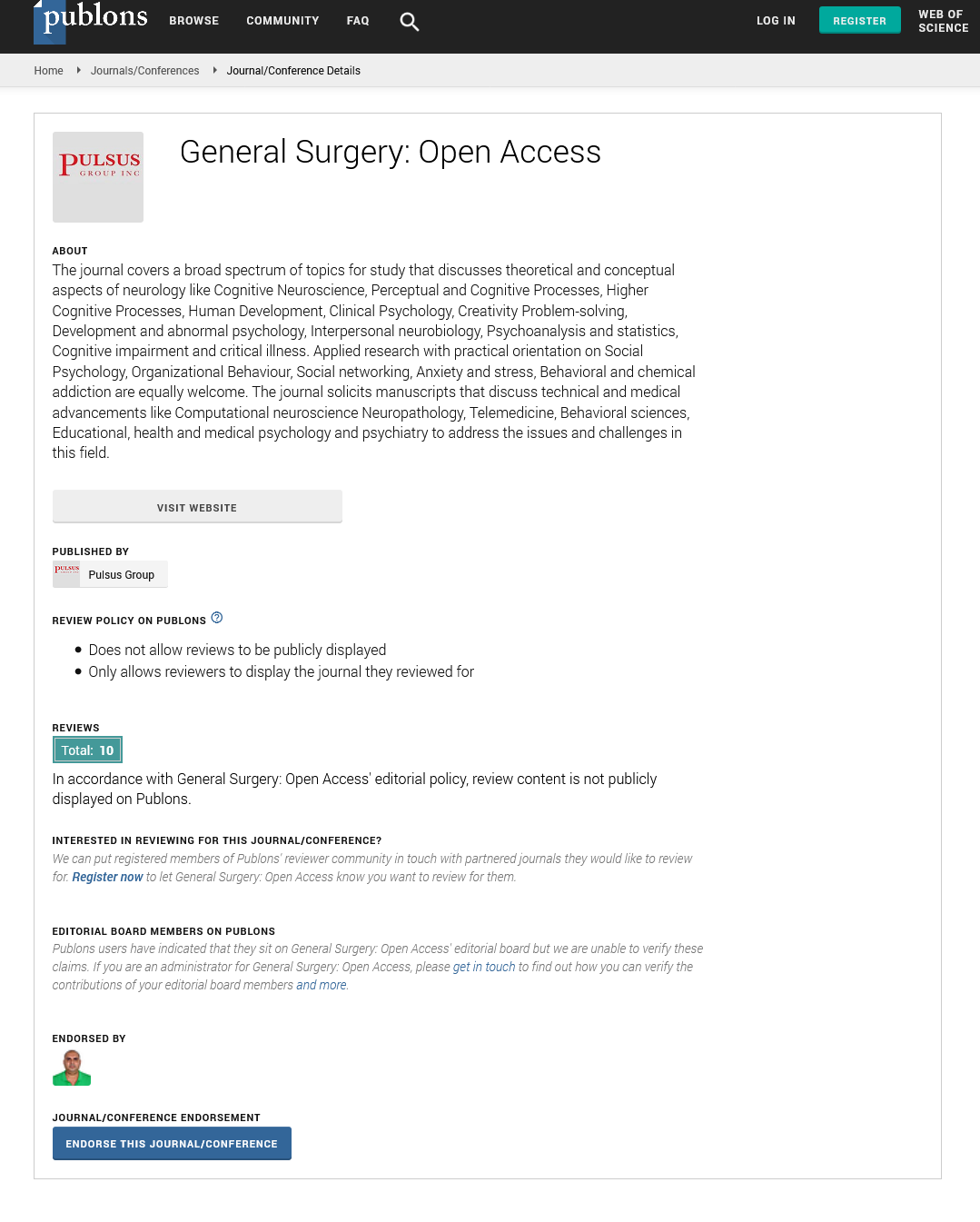The effect of COVID-19 on dental care in Kuwait: A retrospective analysis from the biggest hospital in the country
Received: 03-Aug-2022, Manuscript No. PULGSOA-22-5222; Editor assigned: 05-Aug-2022, Pre QC No. PULGSOA-22-5222; Reviewed: 19-Aug-2022 QC No. PULGSOA-22-5222; Revised: 03-Oct-2022, Manuscript No. PULGSOA-22-5222; Published: 10-Oct-2022
Citation: Smith D. The effect of COVID-19 on dental care in Kuwait: A retrospective analysis from the biggest hospital in the country. General Surgery: Open Access 2022;5(3):1-2.
This open-access article is distributed under the terms of the Creative Commons Attribution Non-Commercial License (CC BY-NC) (http://creativecommons.org/licenses/by-nc/4.0/), which permits reuse, distribution and reproduction of the article, provided that the original work is properly cited and the reuse is restricted to noncommercial purposes. For commercial reuse, contact reprints@pulsus.com
Abstract
The COVID-19 epidemic has altered dentistry procedures all over the world. This investigation aimed to determine how the COVID-19 pandemic affected the trends in comparisons with data from a big Kuwaiti hospital's dental treatment attendance the pandemic's year before. 176,690 appointment records from 34,250 patients made up the total presenting to Kuwait's AlJahra specialty hospital for dental care between April 2019 and April 2021 was examined. The different sorts of processes and the departments that submitted them were examined, and attendance trends from before and after the epidemic were contrasted. Orthodontic, endodontic, and periodontal operations had a large drop in volume, however oral surgery, restorative dentistry, and paediatric dentistry remained unaffected. The number of patients receiving dental care has increased again, although there has been a noticeable change in the way that some dental procedures are used.
Keywords
Access to dental care; COVID-19; Dental public health
Introduction
In more than 188 countries and impacting more than 7 million individuals, the World Health Organization (WHO) declared a worldwide public health emergency on January 30, 2020, and a pandemic on March 11, 2020 [1]. The COVID-19 epidemic has altered dental procedures all across the world. Dental offices all around the world have had to figure out techniques to limit aerosols in practises because to the virus's ability to spread via aerosols. Additionally, statistics are starting to emerge that demonstrate how the pandemic has affected various dental specialisations differently [2].
The literature and the studies have both revealed how COVID-19 affected Kuwait. A quick and forceful shutdown between 1 April and 30 May 2020 was one of the harsh steps the state used to combat the epidemic. Kuwait had changes in both the number of patients and COVID-19 mortality from the time the pandemic was declared in March 2020 and the first vaccinations were given in April or May 2021. No information is available, however, about the impact of these variables on patients' attendance at dental clinics in Kuwait. Since 1951, all Kuwaiti citizens have had access to dental treatment through a mix of subsidies and perks. But since 1992, the economy has expanded and improved, so dental care in Kuwait is now offered by both the government and private sectors. While private clinics charge a fee for their services, everyone who qualifies can receive free dental care at the government hospital. Despite the expansion of private dental care in Kuwait, the research has shown the contribution of government facilities to the delivery of dental care and their effects on the general wellbeing of Kuwaiti citizens. The Kuwait dental administration at the ministry of health has developed an integrated medical system based on advised scientific policies and a precise methodology in the many dental specialities, which constitute the most financially and humanly resource intensive medical professions. In Kuwait, dental treatments are offered in polyclinics located in various residential areas to a total of 1,083,272 patients. The AlJahra Specialized Dental Center (ASDC) treats about 22.1% of patients who are sent from polyclinics to specialised centres, making it the biggest of the many governmental polyclinics [3].
The ASDC is a component of the brand new AlJahra hospital, which is located in the largest and most populous of the six Kuwaiti governates AlJahra with a population of 452,596 inhabitants, the AlJahra governate and the neighbouring AlJahra districts are served by the ASDC. This was one of Kuwait's busiest dental care facilities before the epidemic, treating more than 20,000 patients annually [4].
Data from all across the world are beginning to reveal that different access to dental care has replaced peoples' initial hesitation to seek dental treatment during the epidemic. Although some attempts have been made to evaluate data from several locations, there isn't much longitudinal data from a sizable public hospital. The world has witnessed the pandemic gradually begin to exhibit characteristics of an endemic due to the virus's newer strains and greater transmissibility. For a better understanding of how dentists throughout the world might address the issues faced by this new phase of the illness, data on how the COVID-19 epidemic affected services are crucial. By comparing data from the year before the COVID-19 pandemic to current data, this study aimed to determine how the COVID-19 pandemic affected patterns of dental treatment attendance at the AlJahra Specialized Dental Center (ASDC) [5].
Discussion
Since the first COVID-19 case was identified more than two years ago, the effects on dentistry are becoming more apparent. The goal of this study was to track the trends in patient care one year after Kuwait's initial COVID-19 limitations went into effect. This study aimed to depict how dental practises changed as the epidemic advanced in order to better understand how dental practises throughout the world are adjusting to limits brought on by the pandemic.
Dental offices all throughout the world effectively shut down during the early phases of the pandemic, from April 2020 to July 2020. A combination of worldwide shutdowns and/or lockdowns, a lack of clear standards on aerosol dangers, and decrease in instances seen between April and July 2020 is due to the fact that elective dental operations were not done. Patients were seen more often as limits on aerosol generating treatments were gradually relaxed. According to our data, there was a significant rise in the number of patients seen for examination and operation between June and July 2020. This can be explained by the fact that emergency operations were given a lower priority since operatories were permitted to execute aerosol generating procedures. This is also consistent with research that revealed the early stages of the pandemic's emergency operations were limited to extractions.
Conclusion
According to the study's findings, even though the AlJahra hospital's dentistry clinics are now seeing almost as many patients as they were before the epidemic, the treatments that are being done have changed significantly. Future studies on the long term effects of these changes are necessary to offer patients with complete dental care and to better prepare for pandemic waves in the future.
References
- Campus G, Diaz Betancourt M, Cagetti MG, et al. The COVID-19 pandemic and its global effects on dental practice. Int J Dent. 2021; 33(11):863-7. [Crossref] [Googlescholar] [Indexed]
- Farshidfar N, Jafarpour D, Hamedani S, et al. Proposal for tier based resumption of dental practice determined by COVID-19 rate, testing and COVID-19 vaccination: A narrative perspective. J Clin Med. 2021;10(10):2116. [Crossref] [Googlescholar] [Indexed]
- Dong Q, Kuria A, Weng Y, et al. Impacts of the COVID-19 epidemic on the department of stomatology in a tertiary hospital: A case study in the General Hospital of the Central Theater Command, Wuhan, China. Commun Dent Oral Epidemiol. 2021;49(6):557-64. [Crossref] [Googlescholar] [Indexed]
- Salgarello S, Salvadori M, Mazzoleni F, et al. The new normalcy in dentistry after the COVID-19 pandemic: An italian cross sectional survey. Dent J. 2021;9:86. [Crossref] [Googlescholar] [Indexed]
- Singh H, Maurya RK, Sharma P, et al. Aerosol generating procedural risks and concomitant mitigation strategies in orthodontics amid COVID-19 pandemic An updated evidence based review. Int Orthod. 2021;19(3):329-45. [Crossref] [Googlescholar] [Indexed]






